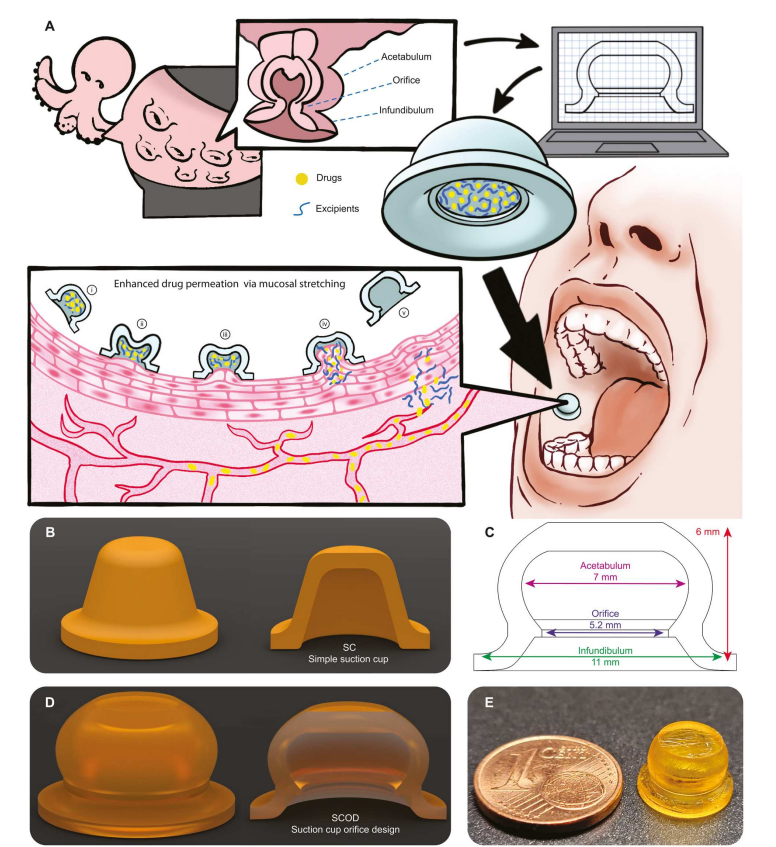Written by Esther Swamidason
In the world of medicine, delivering drugs to patients is a critical challenge. There are various methods to get medications into the body. Among them, the most effective approach has been intravenous (IV) Injection which allows for rapid drug delivery and precise dose control. However, it is not preferred by many due to being an invasive process and its poor suitability for long-term therapy or self-administration. Contrarily, oral drugs and transdermal patches are more comfortable approaches. The drawbacks of these methods are that they may cause an allergic reaction or may not be suitable for all patients, the drug absorption varies from person to person and the onset of reaction is fairly slow. Therefore, despite the numerous options of drug delivery available today, researchers have been searching for a more effective and patient-friendly approach.
Nature’s inspiration behind the suction cups
Scientists often draw inspiration from nature to develop innovative solutions in the medical field. Here are a few examples of how nature has influenced medical technologies. For example, bandages that adhere to skin without causing damage when removed were developed by observing a gecko’s remarkable climbing ability due to their adhesive toe pads! To add, antibacterial surfaces in healthcare settings mimic the texture of sharkskin which is known for its ability to resist microorganisms’ attachment. In this case, scientists turned to the octopus, which uses its suction cups for a variety of tasks, including capturing prey. Researchers aimed to create a drug delivery system inspired by the way an octopus’s suction cups work. These small rubber suction cups filled with medication turned out to be more effective than traditional tablets at getting drugs into the bloodstream. Plus, were far less painful and invasive that needles and injections!
How do the suction cups work?
These small rubber suction cups can be placed inside the cheek. These cups then stretch the cheek, creating a larger surface area for drug absorption. To test the effectiveness, the research team used 3D-printed rubber suction cups filled with a diabetes drug. They placed these cups inside the cheeks of beagle dogs, which have a similar inner cheek lining to humans. The results were impressive: the bloodstream more than 150 times higher compared to traditional tablet delivery. To expand on its mechanism, this research introduces a novel approach that combines the mechanical stretching of buccal mucosa (cheek cells) with chemical permeation enhancers. Next they tested it on some volunteers who self-applied water-filled patches to test how well they would stay in place while talking, moving, and rinsing their mouths. The vast majority found the patches to be comfortable and preferable to injections for daily, weekly, and monthly drug applications.

Is there a future for the cups?
While the technology still needs further testing for repeated use and safety, the researchers believe it holds great promise. They emphasize that this approach is non-invasive, simple, and can be applied by patients themselves. There is very minimal damage caused to the buccal mucosa and very quick recovery from minor damage after patch removal. It could potentially be used for a wide range of drugs that don’t absorb well in the gastrointestinal tract.
One limitation of the study is that the number of permeation enhancers used and their doses explored are quite limited. Therefore, the optimal choice of enhancer and their most effective concentration to ensure safety was not studied. We still do not know about factors such as their scalability, adaptability to different drugs and long-term safety. However, the research team plans to bring their suction-cup design to the market. This requires conducting more tests and securing industry partners and funding.
What makes the cups unique?
Despite its shortcomings, these rubber suction cups have several unique features that sets it apart from traditional drug administration methods:
- Non-invasive approach: since no skin or blood vessels are punctured, patients’ discomfort level is greatly reduced.
- Enhanced absorption: it works 150 times better in delivering the drug to the bloodstream than tablets!
- Wider application: the technology holds promise for drugs that are not absorbed well in the gastrointestinal tract.
- Targeted delivery: the cups deliver drugs directly to the bloodstream reducing the risk of side effects and waste of medication.
In conclusion, we see that nature, once again has played a pivotal role in guiding the path of scientific research progress. Once we embrace this innovation in the medical world, we may joyously kiss goodbye to painful needles, injections and nasty tablets forever!
References
Luo, Z., Klein Cerrejon, D., Römer, S., Zoratto, N., & Leroux, J.-C. (2023). Boosting systemic absorption of peptides with a bioinspired buccal-stretching patch. Science Translational Medicine, 15(715). https://doi.org/10.1126/scitranslmed.abq1887
Naddaf, M. (2023) This octopus-inspired patch could deliver drugs like ozempic through your cheek, Nature News. Available at: https://www.nature.com/articles/d41586-023-03050-1 (Accessed: 09 November 2023).


